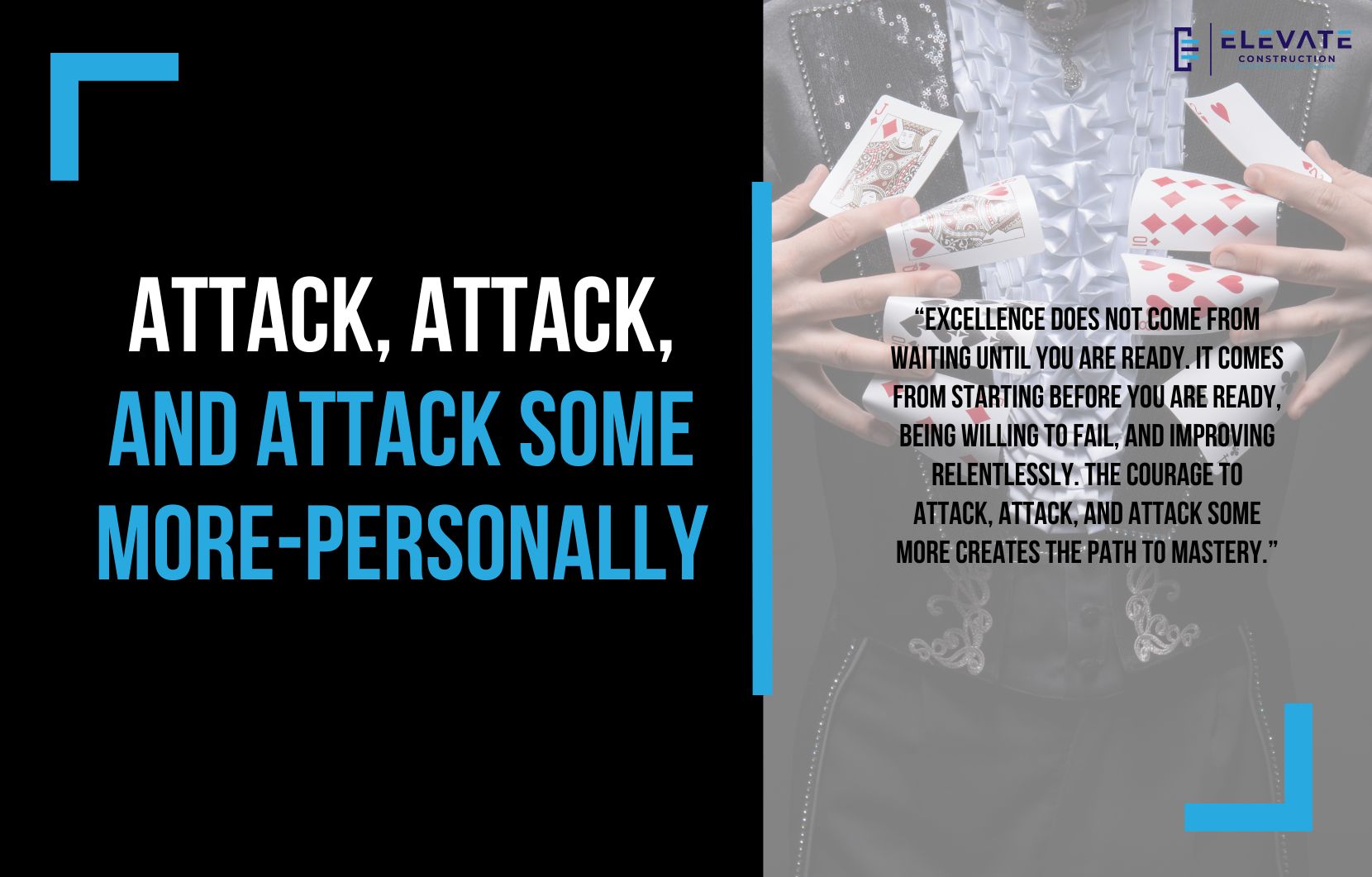Attack, Attack, and Attack Some More
One of the biggest mistakes I see in our industry and in life is waiting for perfection before starting. We think once we know everything, once we have the perfect plan, then we’ll take action. But here’s the truth: nothing worthwhile gets perfected before it is started. Progress happens when you attack, attack, and attack some more.
I have lived this principle many times. When I first learned lean with my project team, we did not know everything about daily huddles or weekly work plans. We just started. We created the space, implemented huddles, and built culture. Was it perfect? Absolutely not. But the act of starting and iterating made all the difference.
Each project after that, we layered on more: better visuals, more robust systems, full use of tact and last planner, worker huddles, engineering processes, and preconstruction structuring. Every project became stronger because we were willing to begin before we had mastery.
That same principle shaped the integrated production control system. The first version was just an outline in a notebook. Then we tested it in boot camps, where it evolved into games, Miro boards, Canva graphics, a training manual, and eventually the full-blown system we have today. If we had waited until it was perfect, it would never have been born. By version 7, it was useful. By version 15, it was remarkable. Today, it is the backbone of our super PM bootcamps.
The same story applies to our tact control boards. The first twelve iterations were rough. They sucked. But each draft improved. Today, the boards are polished tools with magnets, formatting, and structure that project teams rave about. And we are still improving them every time we use them.
This willingness to draft, fail, and improve is not weakness. It is the essence of progress. Paul Akers showed this brilliantly when he reimagined the airline boarding pass. His first versions were clunky, but after many iterations and asking for feedback again and again, he created a version that could change the travel experience for millions.
In our work with prefabrication, we have seen this firsthand. A team drafts a plan, tests it, and then adjusts it. The initial version is not the final answer. It is the starting point that allows improvement.
Here’s the lesson: nothing will ever be right the first time. You will not master pull planning on your first attempt. You will not create the perfect logistics plan in version one. You will not design the perfect huddle space or meeting format without first trying it and realizing what does not work.
Iteration is the path to excellence. The first draft might be ugly. The second draft will be less ugly. By the fifth or seventh, you are close. By the fifteenth, you are leading the industry. But none of that happens without the courage to start and to suck at it in the beginning.
Kate’s journey with graphics is a perfect example. Her first hundred attempts were rough. But now, through practice and persistence, she creates industry-leading visuals that elevate our books, websites, and training materials. The quality you see today is built on the back of hundreds of drafts that nobody sees anymore.
The same goes for our websites, our books, and our guides. The first versions were terrible. But they existed. And because they existed, we had something to improve. Today, those resources are world class.
If you are holding back from implementing lean, tact, pull planning, or any system because you think you need more training or more confidence, stop. The only way to gain confidence is to act. The only way to learn is to start. The only way to succeed is to attack, attack, and attack some more.
When safety and compliance are at stake, yes, be deliberate and precise. But when it comes to creative systems, collaboration, and continuous improvement, perfection is the enemy of progress.
Do not wait. Do not hide behind excuses. Do not let fear of failure stop you from beginning. The first draft will not be the last draft. The important thing is that there is a draft. Because once you have something to review, something to test, and something to iterate on, you are on the path to excellence.
So whether it is your first pull plan, your first huddle, your first logistics board, your first sign, or your first schedule, do it. Fail. Learn. Do it again. By the time you reach version seven, you will be amazed at how far you have come. And by version fifteen, you will have something remarkable that sets you apart from everyone else.
Attack, attack, and attack some more. That is how you build mastery, transform teams, and elevate your work.
Key Takeaway
Excellence does not come from waiting until you are ready. It comes from starting before you are ready, being willing to fail, and improving relentlessly. The courage to attack, attack, and attack some more creates the path to mastery.
If you want to learn more we have:
-Takt Virtual Training: (Click here)
-Check out our YouTube channel for more info: (Click here)
-Listen to the Elevate Construction podcast: (Click here)
-Check out our training programs and certifications: (Click here)
-The Takt Book: (Click here)
Discover Jason’s Expertise:
Meet Jason Schroeder, the driving force behind Elevate Construction IST. As the company’s owner and principal consultant, he’s dedicated to taking construction to new heights. With a wealth of industry experience, he’s crafted the Field Engineer Boot Camp and Superintendent Boot Camp – intensive training programs engineered to cultivate top-tier leaders capable of steering their teams towards success. Jason’s vision? To expand his training initiatives across the nation, empowering construction firms to soar to unprecedented levels of excellence.
On we go

